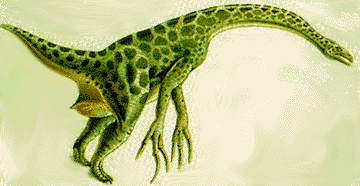
Therizinosaurus
cheloniformis -Maleev, 1954- claw
Archosauria: Saurischia: Segnosauria: Therisinosauridae
Locality:
Nemegetu, Gobi Desert, southeastern Mongolia
Age: Late
Cretaceous (Late Campanian-Early Maastrichtian), 74 million years ago
The
segnosaurs come only from the Late Cretaceous of Mongolia
and China
and are not studied well enough because of the insufficient fossil record.
They
were large or medium-sized bipedal plant-eaters with
a relatively small head,
massive body and stout hindlimbs.
The relatively very long and powerful forelimbs
in segnosaurs possessed giant claws that
might be up to 80 centimeters (2.6 feet)
in length, like in Therizinosaurus from Mongolia.
They
were probably gentle herbivores.
They used their large forelimbs and claws to
pull down branches on which to browse.
The claws with the horny sheath that would
have fitted over the outside of the bone may
have been up to one meter long.
The
large intestinal cavity further indicates the herbivorous nature of this animal.
This
picture of Therizinosaurus cheloniformis as browsers in a forest agrees well
with
the view that conditions in Central Asia had become much more moist than what
they
had been like 10 million years before these dinosaurs lived.
Anecdote:
The
bones of a Therizinosaurus were found inside the skeleton
of the Tyrannosaurus
exhibited with the Russian Dinosaur Exposition.
These
bones were found during the laboratory preparation of the Tyrannosaurus.




